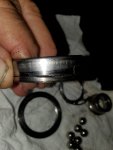So... is the assignable cause for the most recent failure a component that was compromised during the wreck or the use of unapproved fluid?
I don't think anybody could answer that question definitively from some pictures on the internet.
Poor lubrication could lead to excessive wear of transmission components. As parts wear, clearances increase and I have seen transmissions where excessive clearances allowed gears to bind or even be forced apart, breaking clips and castings, under load. I have also seen worn bearings bind, jam and come apart under load. So it is my personal opinion that it is
possible that poor lubrication was a contributory factor.
A conceivable scenario is that sloppy transmission bits rattled around but in general alignment until subjected to an unusually higher force -- such as pushing the tree over -- that finally popped the clip out of place allowing further binding. The subsequent drive home, with repeated stalling and shifting of gears to get it moving again, caused further damage. Or maybe the bearing jammed and broke first, pushing the clip out of place. Who knows? I certainly can't tell from here.
All that said, I would think that wear caused by poor lubrication would first manifest itself in the HST pump and motor. They are built to very close tolerances and wear there should result in low HST pressure. In other words, I would have thought you would have problems driving to the tree in the first place, not just driving home after pushing it over.
As for Fram filters: they earned a very poor reputation 20-odd years ago when certain ones started falling apart internally. This coincided with the rise of the internet forums. Since then they have probably been subjected to the most internet scrutiny of any brand. A couple of specific model recalls due to faulty crimping, incorrect dimensions and gasket failures didn't help their reputation any.
Note that Fram makes a few product lines at different price points. Is their budget line really any worse than a comparably priced line from another manufacturer? I doubt it. Is their higher priced line better than their budget line? Probably -- the better line has a greater filtration surface area, anyway. They do make the OEM filters for a few different engine manufacturers so they do know how to make a decent filter if they want to.
Now Kubota brand filters only have one line. They are probably not made by Kubota themselves. In fact, they may be made by different manufacturers at different times. OEMs typically call for bids based on certain specs from time to time.
I don't know about your tractor, but on mine, Kubota used a by-pass filtration system. If the filter is too restrictive, there will be less overall filtration. If the filter media is not dense enough, it won't filter to the required density. It's a Goldilocks thing -- needs to be juuuust right.
The advantage of paying a couple of bucks more for the Kubota name on the can is that you don't have to compare filter density, filter area, anti-drain back valve, pressure rating, flow rate, etc. etc. to ensure the aftermarket filter actually meets the Kubota spec. Someone else did that for you already.


















